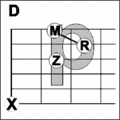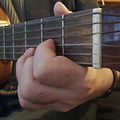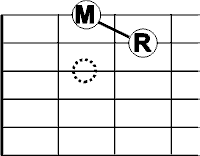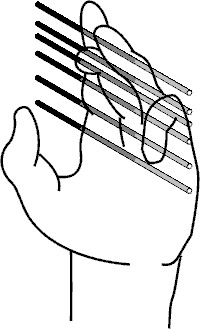Guitar/Chord changes from G to D
This page is currently being translated from Germans Wikibooks into English. • Expect some errors and inconsistencies. •Images has to be repainted. The German fingering ZMRK = imrp (Z = Index, K = small Finger = pinKy •Some German words in pictures has to be translated. • Assisted the translator because he is not a native speaker. Feel free to correct mistakes and style. • The Wikitorians among you may help me with the peculiarities of English Wikibooks. (how do you handle things, what are your preferd templates...). •delete {:Guitar/under construction - in translation}if you think the translation is largely error-free and good enough.• Be patient. The translation of the finished German lesson (links in the navigation) will take time. |
Original page translated by Google
The chord change from D to G
[edit | edit source]Audio example:
Support finger
[edit | edit source]From G to D
[edit | edit source]Now the whole thing goes backwards again:
Audio example:
Once again:
| Tip: |  If you still have difficulties with your little finger, imagine you are holding something with it (like the bunch of keys here). The little finger first has to get used to being able to move fully like the other fingers. And for people who are not used to this, it takes a lot of practice and habit. Incidentally, you also face the same problem when you try to learn the 10-finger blind system for the typewriter. Firstly, the little finger has to get used to the motion sequence, and then it has to get used to the pressure with the fingertip, which it may not have done to the same extent before. But they can do it to the extent that you can actually reach both the upper and lower E strings. The palm of your hand should not touch the fingerboard so that your fingers have enough space. Even people who still find it very difficult learn it. It might take a little longer. Then help Finger gymnastics and stretching exercises (with the aid of the plucking hand). The fingering with the pinky actually has many advantages, so it's worth the effort. (see:G without pinky) |
|---|
| Tip: | ;(not only) for the guitar teacher
At the beginning it is best to only practice songs with the learned chord changes.
The jump from G major to A major should come a little later. |
|---|
Which trick or learning aid works best for you ultimately depends on the individual, of course. But it is worth using all the tools available to help you memorize a chord sequence or teach it to others. This makes use of the learning psychology phenomenon: the more senses are addressed, the easier it is to learn.
Pay attention to the opening
[edit | edit source]Here too, pay attention to which word is emphasized first. Only then does the actual bar begin (i.e. the "1" of the beat pattern).
- O when the [D]saints go matching in...
- We [D]come on the sloop John B. ...




















